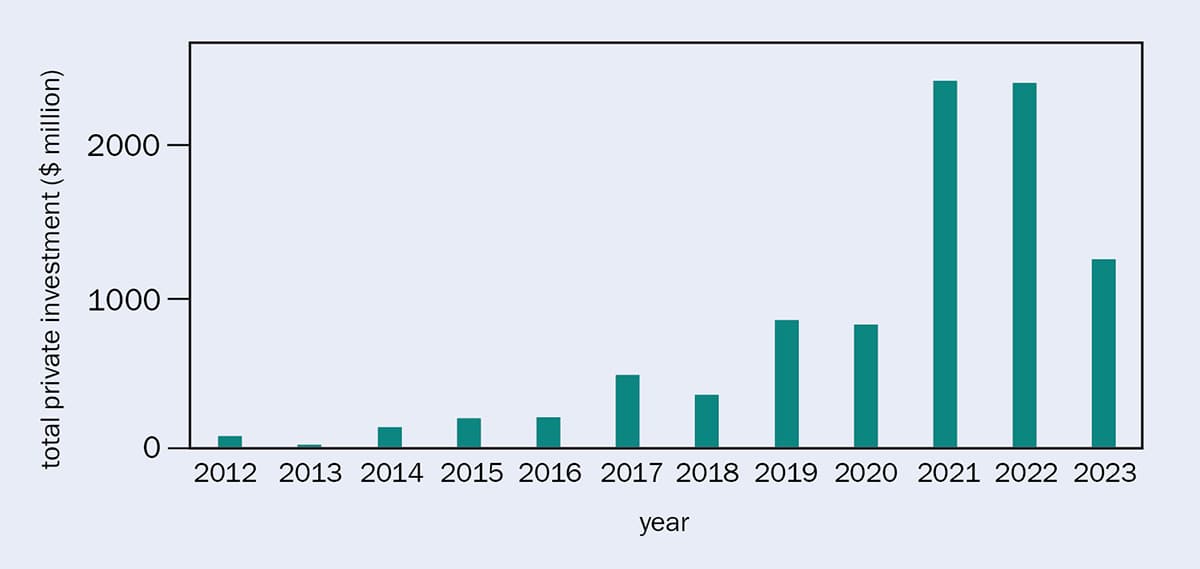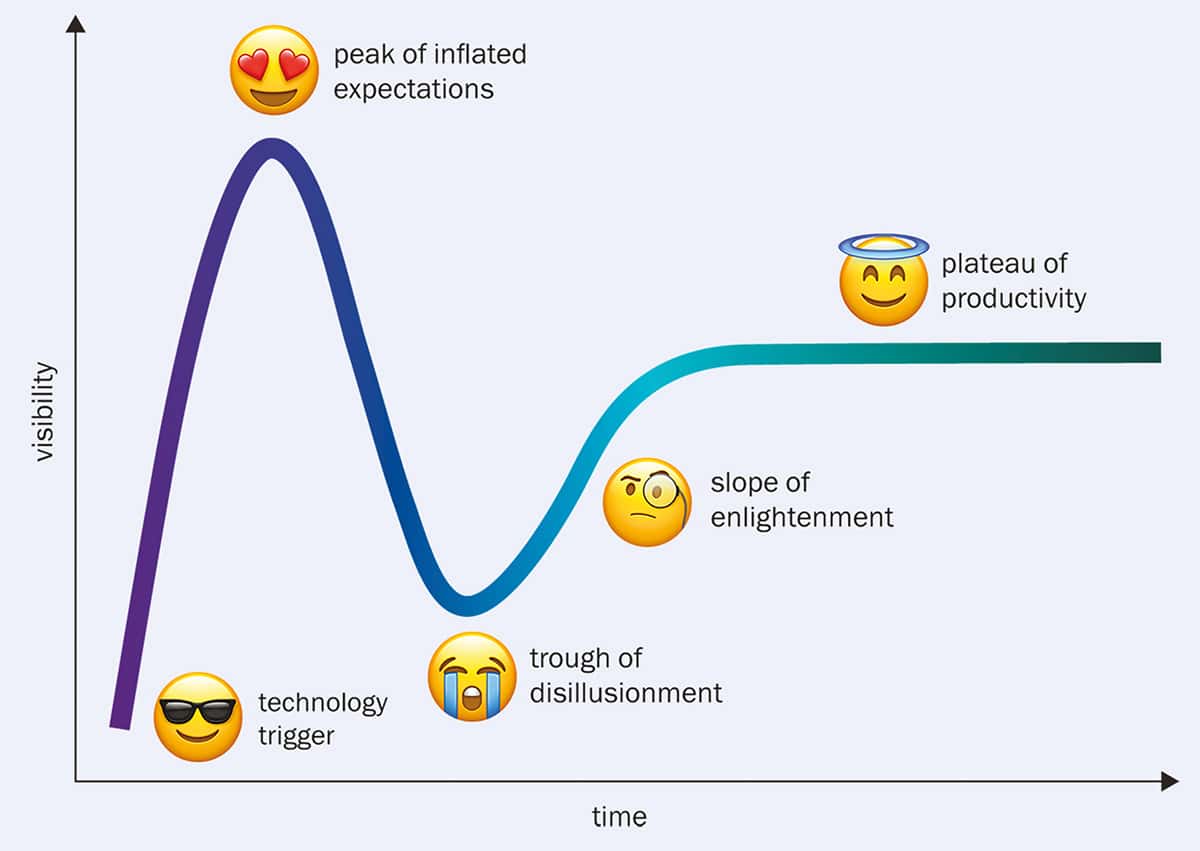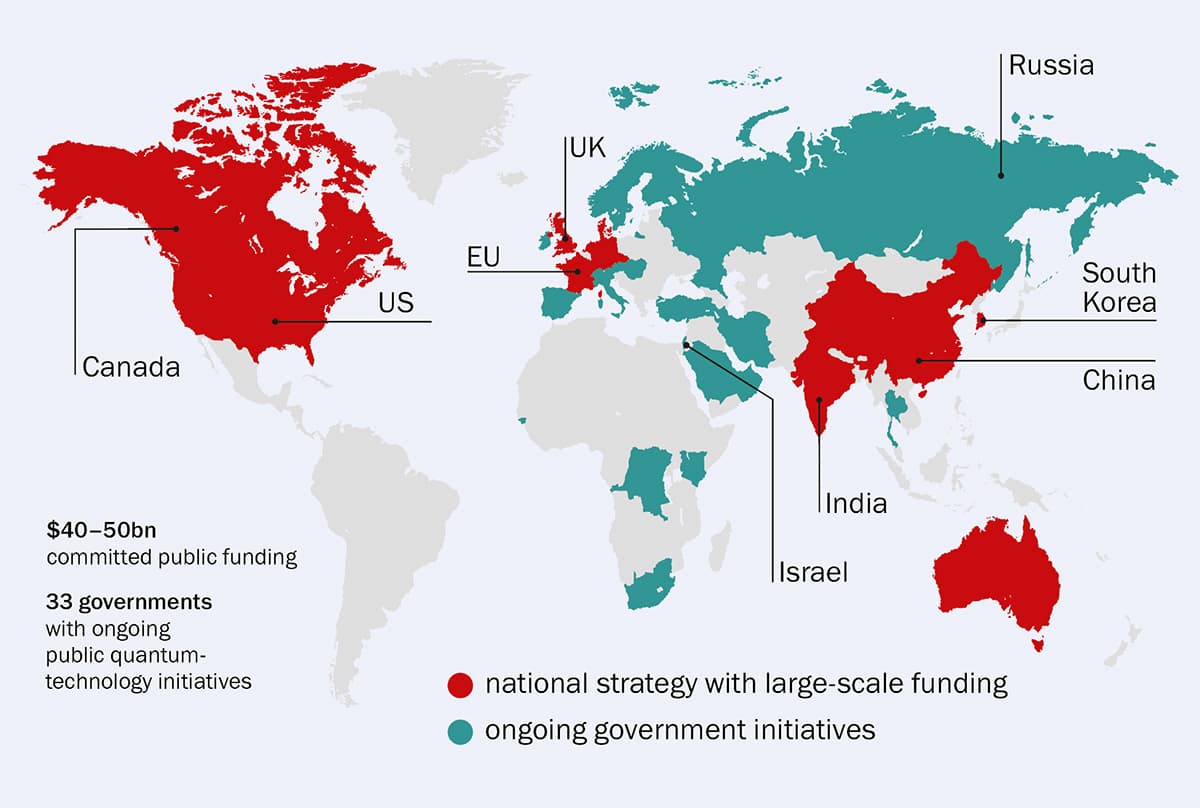A recent fall in global private investment in quantum technology has led to suggestions that the sector is heading for a downturn. James McKenzie is unfazed and believes the future for the sector is bright

For politicians, funders and investors, science isn’t always on their radar. But from time to time, certain fields do capture wider attention. We saw that in the 1950s with nuclear power, which some thought would one day be “too cheap to meter”. Later, nanotechnology and graphene rose to the fore. More recently, artificial intelligence and quantum technology seem to be on everyone’s mind.
Quantum tech is no longer just about semiconductors, quantum dots, electron microscopes and lasers, which are “first-generation” technologies. Instead, the focus is on harnessing superposition, uncertainty and entanglement to develop “second-generation” quantum technologies.
Such “quantum 2.0” technology could revolutionize everything from computing and measurement to sensing, timing and imaging. Whether it’s engineering, transport, navigation, finance, defence or aerospace, quantum tech could disrupt the economy too. In fact, most leading nations these days have a quantum strategy, though China out in front in terms of financial muscle, having ploughed $25bn into quantum tech up to 2021.
However, investment in quantum tech could be taking a potentially worrying turn, according to the recent report State of Quantum 2024. Published in January by the Finland-based firm IQM Quantum Computers, venture capitalists OpenOcean, European tech investors Lakestar and The Quantum Insider (TQI), the report warned that investment in the sector around the world has fallen by 50% since a high in 2022.

State of Quantum 2024 says that global investment in quantum technology, which peaked at $2.2bn in 2022, had dropped to $1.2bn the following year. The steepest fall was in the US, which plummeted by 80%, with Asia-Pacific investment reducing by 17%. The situation in Europe, the Middle East and Africa (EMEA) was slightly better, with investment growing marginally by 3%.
The drop in investment has led some commentators to suggest we are heading for a “quantum winter”, which seems dramatic but perhaps just reflects the notion that investors are getting more tuned into emerging markets and recognizing that the practical applications of quantum computing could still be many years away. It’s also worth remembering that, for all the hype, quantum technology remains a niche sector, accounting for less than 1% of total venture capital funding globally.
The hype cycle
As I pointed out last year, many technologies follow a graph devised in 1995 by Jackie Fenn, an analyst from US tech consultants Gartner Inc. Now known as the “Gartner hype cycle”, it shows how the expectation surrounding a particular technology develops over time. Having lived through a fair few technology cycles myself, I can safely say that the graph is pretty accurate.

We start with a “technology trigger”, when everyone notices something big going on. Interest rises, money flows in until we reach a “peak of inflated expectations”. Then, as people realize things are harder and trickier than imagined, we hit a “trough of disillusionment”. Later, activity picks up again via a “slope of enlightenment” until we hit a “plateau of productivity”, where firms – finally – realize what works and know what customers want.
If the hype cycle is true of quantum tech – and I have no reason to think it isn’t – then the current fall in investment is probably a combination of being around the top of the cycle and global economies slowing down. That’s not necessarily a bad thing. I am sure that more informed investors are selecting the stronger technologies and companies as market opportunities and the timings of applications are becoming clearer.
In any case, there are still big sums involved, with investment in EMEA continuing to rise. And as The Quantum Insider report points out, lots of great progress is going on at quantum research centres across the globe. One example is the UK’s National Quantum Computing Centre, which aims to allow early access to quantum computing for UK businesses as part of the country’s national strategy.
The most talked-about quantum 2.0 tech is, of course, quantum computing. It grabs all the headlines and excitement, which is not surprising given that the demand for such machines is potentially huge. According to a report published last year by Markets and Markets, the quantum-computing sector could be worth a staggering $4.4bn by 2028.

Much of that demand is being driven by the need for large machines with up to 10,000 quantum bits (qubits). Such devices would be used to decrypt data that have been stored with relatively low amounts of encryption (although, ironically, such data will probably be old and not that valuable). Still, if powerful quantum computers become a reality, their ability to crack historical encryption algorithms will compromise the security of the Internet and damage global security.
However, there are likely to be lots of other, more immediate applications of quantum computers with fewer qubits. Many companies are making headway in this area, with one stand-out being ORCA Computing, which in 2020 won a business start-up award from the Institute of Physics (IOP). Richard Murray, ORCA’s chief executive who is a trained physicist, recently told Forbes that the firm had sold five of its systems, with four already installed at three different sites around the world.
ORCA’s machine (an error-corrected photonic quantum computer) is the first of its kind that can work at room temperature. The latest sale involves the supply of a system to the UK’s publicly funded NQCC, which is based on the Harwell Innovation Campus in Oxfordshire. ORCA’s system will provide a testbed facility for machine learning, combining quantum and neural networks technologies.
But as Murray pointed out in another Forbes article, the challenge is working out what quantum computers can best be used for. That’s not easy, with many potential customers not understanding the benefits until they see working systems that can solve their problems. What is clear, though, is that quantum computers will be particularly good at tackling certain problems that are difficult or even impossible for classical computers to solve.
The challenge is working out what quantum computers can best be used for
The race is on in this high-stakes, high-reward sector, with IBM recently announcing a 1000 qubit computer. The company has been following a quantum-computing road map that roughly doubled the number of qubits every year. In 2021 IBM had a 127-qubit device and in 2022 it had one with 433 qubits. Its latest chip, called Condor, has 1121 superconducting qubits. Rather tellingly, however, the company says it will now shift gears and focus on making its machines more error-resistant, as this is clearly going to impact the ability of potential customers to use them in the near term.
But in terms of applications of quantum 2.0 tech, I believe there is lots of promise in quantum clocks, quantum sensors and quantum-imaging technology, especially once they reach certain usability criteria outside the lab. In this regard, the work of the UK Quantum Technology Hub on sensors and timing, led by the University of Birmingham, is world class, as are some of the companies associated with it.

Take Cerca Magnetics, which won an IOP business-innovation award for developing the world’s first wearable magnetoencephalography scanner. Using optically pumped room-temperature magnetometers, each sensor element is no larger than a LEGO brick and can measure human brain function with a sensitivity rivalling that of cryogenic superconducting devices.
The company, which has also won the inaugural prize from the IOP’s Quantum Business and Innovation Group (qBIG), has already built a lightweight 3D-printed head-mounted scanner cap and has been installing systems around the world in magnetically shielded rooms. Its device can measure human brain function with what the company says is unprecedented accuracy. Most importantly, it can take data even as a patient moves, rather than them having to stay still while they stick their heads into a large scanner.
Another interesting quantum sensing firm is Bristol-based QLM, which recently demonstrated its latest methane gas quantum lidar camera in an event at the IOP attended by the Duke of Edinburgh. This camera is smaller, more robust and more integrated, allowing it to be used in the field for methane leak detection by customers who are trialling it globally. It was impressive to see how the company had progressed since it won its 2020 IOP business award.
One of my favourite applications of quantum 2.0 technology is quantum gravity sensing, where the aim is to get devices that can be deployed out in the field. Imagine how an understanding of what lies beneath the ground can impact our daily lives. Rather than road workers having to dig up huge stretches of tarmac to mend an underground pipe, they could do rapid, targeted “microsurgery”-style repairs.

When will quantum computers finally break into the market?
Accurate mapping through quantum gravity sensors will really help here, and the University of Birmingham spin-out Delta.g has already raised £1.5m in 2023 to build its quantum gravity sensors for underground mapping. Pete Stirling, the company’s co-founder and chief executive, says its goal is to shrink the technology so that it can be deployed for real-life applications such as looking for hidden infrastructure and carrying out repairs.
“Given the broad applications across myriad industries, we’re hugely excited about our ability to use quantum gravity gradiometry to achieve vast cost-savings and pick up the pace of mapping work in a way that improves everyday life,” Stirling says. Imagine how useful it would be to have a zoomable and searchable “Google maps” database of all the myriad pipes, tunnels and cables that lie hidden under our feet.
So, despite the drop in venture-capital funding and fears of a “quantum winter”, the quantum-tech sector is still going strong and indeed maturing. The amount of funding is not therefore the only number we should focus on. In fact, more traditional metrics like field trials and product or service revenues are more appropriate.
While it may take many years for quantum computers to reach their full potential, there are nearer term applications, and in sensing and timing, where the end goals are clear. Product commercialization is in full swing for what, as far as I’m concerned, is the one of the most exciting branches of physics.
- SEO Powered Content & PR Distribution. Get Amplified Today.
- PlatoData.Network Vertical Generative Ai. Empower Yourself. Access Here.
- PlatoAiStream. Web3 Intelligence. Knowledge Amplified. Access Here.
- PlatoESG. Carbon, CleanTech, Energy, Environment, Solar, Waste Management. Access Here.
- PlatoHealth. Biotech and Clinical Trials Intelligence. Access Here.
- Source: https://physicsworld.com/a/why-you-shouldnt-be-worried-about-talk-of-a-quantum-winter/
- :has
- :is
- :not
- :where
- $UP
- 000
- 1
- 10
- 160
- 1995
- 20
- 2020
- 2021
- 2022
- 2023
- 2024
- 2028
- 33
- a
- ability
- About
- AC
- access
- According
- Accounting
- accuracy
- accurate
- Achieve
- across
- activity
- Aerospace
- africa
- again
- aim
- aims
- algorithms
- All
- allow
- Allowing
- already
- also
- Although
- always
- am
- amount
- amounts
- an
- analyst
- and
- Announcing
- any
- applications
- appropriate
- ARE
- AREA
- around
- artificial
- artificial intelligence
- AS
- associated
- At
- attention
- award
- away
- Bad
- based
- BE
- become
- becoming
- been
- being
- believe
- believes
- below
- beneath
- benefits
- BEST
- Better
- Big
- bits
- Brain
- branches
- Break
- broad
- build
- built
- business
- Business and innovation
- businesses
- but
- by
- called
- camera
- Campus
- CAN
- cap
- capital
- capture
- carrying
- case
- Cash
- centres
- certain
- challenge
- cheap
- chief
- Chief Executive
- child
- China
- chip
- class
- clear
- clearer
- clearly
- click
- Clocks
- CO
- Co-founder
- Coins
- combination
- combining
- commentators
- commercialization
- committed
- Companies
- company
- Company’s
- compromise
- computer
- computers
- computing
- concerned
- consultants
- continuing
- could
- countries
- country’s
- Course
- crack
- criteria
- Current
- Currently
- Customers
- cycle
- cycles
- daily
- damage
- data
- Database
- day
- Days
- Decrypt
- defence
- Demand
- demonstrated
- depicting
- deployed
- Despite
- Detection
- develop
- developing
- develops
- device
- Devices
- different
- difficult
- DIG
- Disrupt
- do
- doubled
- down
- DOWNTURN
- dramatic
- driven
- Drop
- dropped
- Duke
- each
- Early
- East
- easy
- economies
- economy
- element
- EMEA
- emerging
- emerging markets
- encryption
- end
- Engineering
- entanglement
- especially
- estimates
- Europe
- European
- Even
- Event
- eventually
- Every
- everyday
- everyone
- everyone’s
- everything
- example
- excited
- Excitement
- exciting
- executive
- expectation
- Facility
- fact
- fair
- Fall
- Fallen
- Falls
- far
- fears
- Feet
- few
- fewer
- field
- Fields
- Finally
- finance
- financial
- Firm
- firms
- First
- five
- Flows
- Focus
- follow
- following
- For
- Forbes
- fore
- four
- from
- front
- full
- function
- funded
- funding
- further
- future
- Gartner
- GAS
- gears
- get
- getting
- given
- Global
- global investment
- Globally
- globe
- goal
- Goals
- Goes
- going
- good
- Government
- graph
- Graphene
- gravity
- great
- Green
- Ground
- Group
- Growing
- had
- harder
- Harnessing
- Have
- having
- Heading
- Headlines
- heads
- help
- here
- Hidden
- High
- historical
- Hit
- How
- However
- HTML
- HTTPS
- Hub
- huge
- Hugely
- human
- Hype
- i
- IBM
- if
- image
- imagine
- imagined
- Imaging
- immediate
- Impact
- importantly
- impossible
- impressive
- improves
- in
- Inaugural
- Inc.
- indeed
- industries
- information
- informed
- Infrastructure
- initiatives
- Innovation
- installed
- installing
- instead
- Institute
- integrated
- Intelligence
- interest
- interesting
- Internet
- into
- invested
- investment
- Investors
- involved
- involves
- Ironically
- issue
- IT
- ITS
- james
- January
- jpg
- just
- Kind
- Know
- known
- lab
- large
- large-scale
- larger
- lasers
- Last
- later
- latest
- leading
- leak
- learning
- Led
- less
- lie
- lies
- Life
- lightweight
- like
- likely
- Lives
- longer
- looking
- lots
- Low
- machine
- machine learning
- Machines
- made
- Main
- Making
- many
- map
- mapping
- Market
- market opportunities
- Markets
- max-width
- May..
- McKinsey
- measure
- measurement
- methane
- Methane Leak
- Metrics
- Middle
- Middle East
- mind
- money
- more
- most
- moves
- Murray
- muscle
- my
- myriad
- myself
- nanotechnology
- National
- Nations
- Navigation
- Near
- necessarily
- Need
- networks
- neural
- neural networks
- New
- niche
- no
- Notion
- now
- nuclear
- Nuclear power
- number
- numbers
- of
- Old
- on
- once
- ONE
- only
- open
- opportunities
- or
- Other
- our
- out
- outside
- over
- Pace
- part
- particular
- particularly
- patient
- Peak
- People
- perhaps
- phases
- physicist
- Physics
- Physics World
- pick
- Picks
- pipe
- plato
- Plato Data Intelligence
- PlatoData
- points
- Politicians
- potential
- potential customers
- potentially
- power
- powerful
- Practical
- pretty
- private
- prize
- probably
- problems
- Processor
- Product
- product commercialization
- Progress
- progressed
- promise
- provide
- public
- publicly
- published
- Publishing
- Quantum
- Quantum Computer
- quantum computers
- quantum computing
- Quantum dots
- quantum research
- Quantum sensors
- quantum tech
- quantum technology
- quantum winter
- Qubit
- qubits
- Race
- radar
- raised
- rapid
- rather
- reach
- Reality
- realize
- really
- reason
- recent
- recently
- recognizing
- Red
- reducing
- reflects
- regard
- relatively
- remains
- remembering
- report
- research
- revenues
- reverse
- revolutionize
- Rise
- Rises
- road
- robust
- Room
- Rooms
- ROSE
- roughly
- s
- safely
- sale
- saw
- say
- says
- Science
- sector
- security
- see
- seem
- seems
- selecting
- Semiconductors
- Sensitivity
- sensor
- sensors
- service
- shift
- should
- showing
- Shows
- since
- Sites
- situation
- Slowing
- smaller
- So
- sold
- SOLVE
- some
- something
- staggering
- start
- Start-up
- stay
- Still
- stored
- strategies
- Strategy
- strong
- stronger
- such
- suggest
- sums
- superconducting
- superposition
- supply
- sure
- surprising
- Surrounding
- Swing
- system
- Systems
- tackling
- Take
- taking
- Talk
- targeted
- tech
- Technologies
- Technology
- term
- terms
- than
- that
- The
- The Future
- The Graph
- the UK
- the world
- their
- Them
- then
- There.
- therefore
- These
- they
- thing
- things
- think
- this
- though?
- thought
- three
- Through
- thumbnail
- time
- timing
- timings
- to
- told
- too
- top
- Total
- traditional
- trained
- transport
- trials
- true
- tuned
- TURN
- Uk
- Uncertainty
- under
- underground
- understanding
- unFaZed
- university
- unprecedented
- until
- us
- usability
- use
- used
- useful
- using
- Valuable
- Vast
- venture
- venture capital
- Venture Capital Funding
- via
- want
- warned
- was
- Way..
- we
- wearable
- What
- What is
- when
- whether
- which
- while
- WHO
- why
- wider
- will
- Winter
- with
- Won
- Work
- workers
- working
- working out
- works
- world
- world’s
- worried
- worrying
- worth
- would
- year
- years
- You
- zephyrnet













